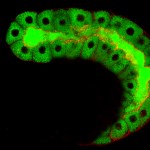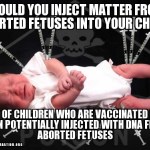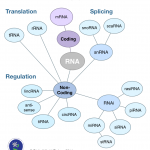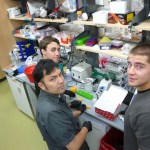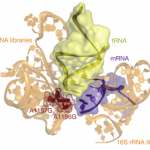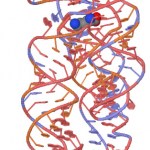RNA
Cells that “spit” out their contents and messenger RNA that is not so swift at delivering its message. Those are two brand new stories on our new and improved website. Check it out and let us know what you think.
The first story arose from a simple question: How do secretory cells – those that produce copious amounts of such substances as tears, saliva or all those bodily fluids – manage to get their contents out of the cell? Cells are walled all the way around; they don’t really have doors for letting things the size of a drop of fluid out. Instead, they use the vesicle system – small globes…
There are some myths, bits of misinformation, or lies about medicine that I like to refer to zombie quackery. The reasons are obvious. Like at the end of a horror movie, just when you think the myth is finally dead, its rotting hand rises out of the dirt to grab your leg and drag you down to be consumed. Of course, the big difference between zombies and these bits of zombie quackery is that in most stories a single shot to the brain will kill the zombie. The same is not true of zombie quackery. You can empty clip after clip of reason, science, and logic into the “head” of the zombie…
Since mental health problems are estimated to affect some 10% of the world’s population, it stands to reason that if you don’t suffer from depression, anxiety or bipolar disorder yourself, you are probably close to someone who does. So you might be pleased to read about a new finding that could eventually lead to a whole new approach to treating this group of common mood disorders.
The finding is that a tiny scrap of RNA – a microRNA that works in the brain – acts as a sort of mood regulator. It works something like the needle in a steam valve. Mice that had high levels of this particular…
Day 4 of the meeting turned out to be pretty exciting for a comparative physiologist as well.
The first session that I went to was called "RNASEQ approaches to understanding extreme physiological adaptations." Considering the Comparative and Evolutionary Physiology section business and dinner meeting was the night before, I was impressed at my ability to make it to an 8:00am session the following morning.
The first seminar from Dr. Brooke C Harrison (Univ. Colorado, Boulder) was on "Extreme cardiac growth and metabolism in the Burmese python after feeding." He spoke about how the cells of…
By @finchtalk (Todd Smith)
In 2014 and beyond Finchtalk will be contributing to Digitalbio’s blog at this site. We kick off 2014 with Finchtalk’s traditional post on the annual database issue from Nucleic Acids Research (NAR).
Biological data and databases are ever expanding. This year was no exception as the number of databases tracked by NAR grew from 1512 to 1552. In the leadoff introduction [1] the authors summarize this year’s issue and the status of the NAR index. The 21st issue includes 185 articles with 58 new databases and 123 updates. In the 1552 database repository, 193 had their…
X-STEM - presented by Northrop Grumman Foundation and MedImmune - is an Extreme STEM symposium for elementary through high school students featuring interactive presentations by an exclusive group of visionaries who aim to empower and inspire kids about careers in science, technology, engineering and mathematics (STEM). These top STEM role models and industry leaders are sure to ignite your students’ curiosity through storytelling and live demonstrations.
Our spotlight on our X-STEM Speakers continues with Biochemist Dr. Robert Tjian from Howard Hughes Medical Institute (HHMI).
Ask…
The first (and sometimes 3rd, 12th, 25th, 134th...) step of any genetic engineering experiment is often extracting DNA from some organism or another. While novel gene synthesis technology will likely make this procedure obsolete, these days it's still most economical to do it by hand. Extracting DNA from fruits like strawberries has also seen a popular resurgence thanks to groups like DIYbio, with instructions for making DNA shots available online for a fun and nerdy party activity. Today my iGEM team extracted RNA from strawberries and oranges to isolate the genes responsible for strawberry…
Almost every living thing shares an identical genetic code, with three nucleic acids in an RNA sequence coding for a single amino acid in the translated protein sequence. While there are 64 three-letter RNA sequences, there are only 20 amino acids and degeneracy in the code allows some amino acids to be coded by multiple codons. Chemists and synthetic biologists in the past few years have been working to expand this genetic code, with unnatural nucleotides that can be incorporated into DNA and RNA sequences and unnatural amino acids that can expand the chemical functionality of proteins.…
Today in my searches for the hot new trends in synthetic biology, I found a news article from Science Daily with an intriguing title: "Scientists Achieve First Rewire of Genetic Switches." Rewiring genetic switches sounds pretty neat, but this headline was intriguing to me first of all because it's kind of late to the party--in fact one of the first papers in modern synthetic biology back in 2000 was about engineered genetic switches: "Construction of a genetic toggle switch in Escherichia coli". When I looked more closely, the article wasn't about this kind of transcriptional switch though,…
For the past few months, the shake-up that began with Next Generation DNA Sequencing has been forcing me to adjust to a whole new view of things going on inside of a cell. We've been learning things these past two years that are completely changing our understanding of the genome and how it works and it's clear we're never going back to the simple view we had before.
What's changed? The two most striking changes, to me at least, are the new views of the way the genome is put together and what the cell does with the information.
They just don't assemble chromosomes like they used to.
I used to…
Before mammals, before dinosaurs, before bacteria, or plants, there was something else; a protocell containing RNA.
The Exploring Origins Project has excellent animations of protocells, a timeline of life's evolution, and best of all- fantastic animations of the RNA world.
You can see how RNA folds, ribozymes (RNA that catalyzes chemical reactions), and learn about the role of RNA when the Earth was young.
BTW- I made this ribozyme image with Cn3D. The RNA is synthetic - made by humans with machines, that is, and this molecule can cut chemical bonds.
This structure is called a "kissing loop" and I find that name just a bit odd, given the source of the structure.
Now, here's the puzzle: Why would I say that the name "kissing loop" is ironic?
